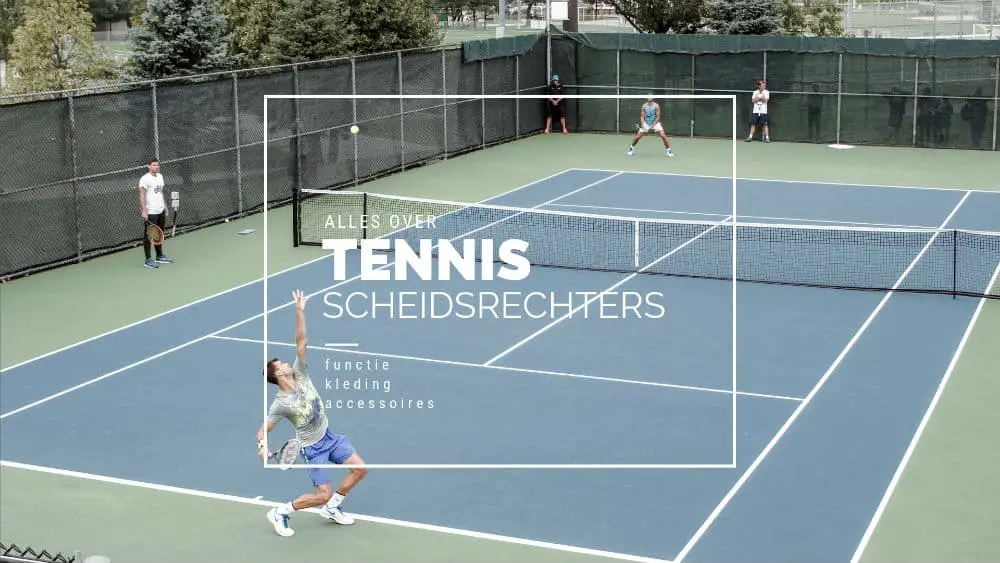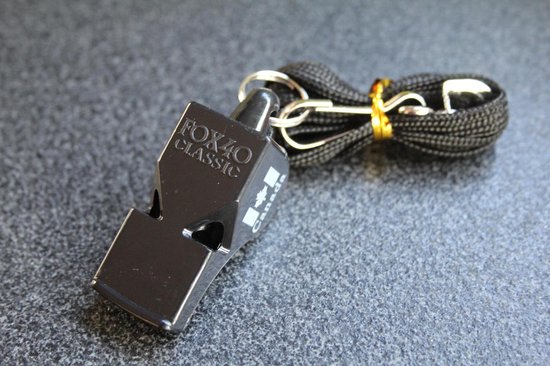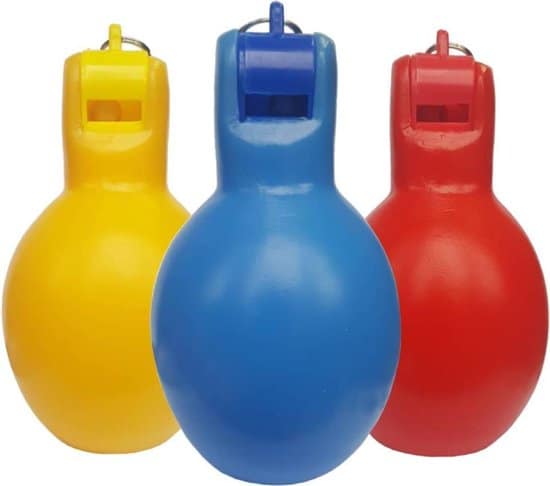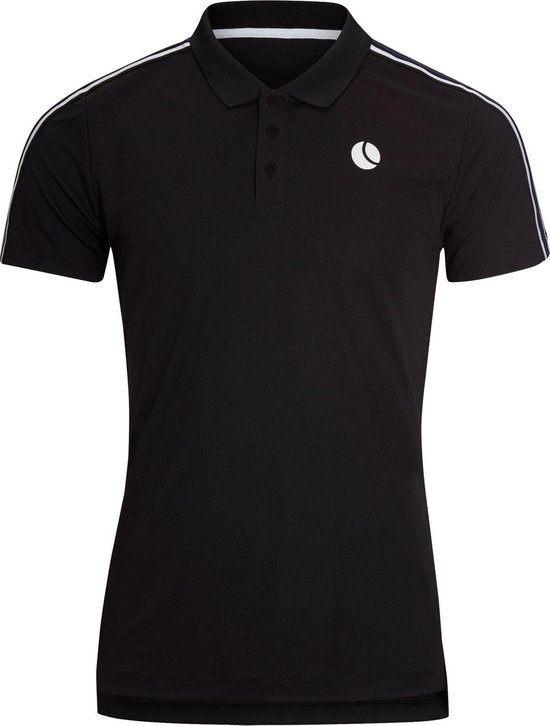I enjoy writing these articles for my readers, you guys. I don't accept payment for writing reviews, my opinion on products is my own, but if you find my recommendations helpful and you end up buying something through one of the links I may be able to receive a commission on that. More information
Previously we have written and provided the necessary information about everything you need to make a:
Although these two sports are super popular in the Netherlands, tennis is certainly not inferior to this.

There are a lot of active tennis clubs and the number is only increasing, partly due to the increasing popularity of Dutch players at major tournaments.
In this article I want to tell you everything about what you need as a tennis referee and what the profession entails exactly.
What we discuss in this comprehensive post:
- 1 What do you need as a tennis referee?
- 2 Job description of the tennis referee
- 3 Do you want to be a tennis referee?
- 4 What does a tennis referee do?
- 5 What do tennis referees wear?
- 6 Can tennis referees go to the toilet?
- 7 How Much Are Wimbledon Referees Paid?
- 8 What is a gold badge referee in tennis?
- 9 How long are the breaks in tennis?
- 10 Conclusion
What do you need as a tennis referee?
Let's start with the basics:
Referee Whistle
To exercise your authority properly, you can use a whistle to pass on signals from your chair. There are usually basic whistles available.
I have two myself, the referee whistle on a cord and a pressure whistle. Sometimes a match takes a lot of time and it is nice to have something with you that you don't have to constantly put on your mouth. But everyone has their preference.
These are the two I have:
| Whistle | Images |
|---|---|
| Best for single matches: Stanno Fox 40 | 
|
| Best for tournaments or multiple matches in a day: Pinch flute Wizzball original | 
|
The right tennis shoes for a referee
Look, finally a job where you don't have to run back and forth all the time. The condition you must have as a field football referee is huge, maybe even bigger than the players themselves.
In tennis it is completely different.
The shoes therefore do not have to offer the best support and running comfort, as with the players. What you want to look at here is actually style and that you look good on the track.
Bol.com has a very extensive choice of sports shoes and is always affordable, plus they deliver nice and fast (view the offer here)
Clothing for a tennis referee
The umpires must have dark colored equipment, possibly with hats or caps. tennis shoes and white socks like these Quick Tennis Socks Meryl 2-pack are desirable. Still, there is plenty to choose from for referees.
A good dark shirt like this one is definitely a perfect choice:

Job description of the tennis referee
So you want to sit in the chair? Want to be 'On' and 'Out' at Wimbledon? It is possible – but it is not easy.
You will have to have a lot of love for Tennis, as well as a hawk eye and complete impartiality. If you have all three of these characteristics, keep reading!
There are two types of referees:
- line referees
- and chair umpires
But you have to have the line before you can sit in the chair – after all, there is a hierarchy here!
A line umpire is responsible for calling when a ball has fallen in or out of the lines on the field of play, and the chair umpire is responsible for keeping score and controlling play.
What is the salary of a tennis referee?
A linesman can expect to earn around £20.000 a year once they get into the professional game where most chair referees make around £30.000.
Once you get to the top, you can earn around £50-60.000 a year as a referee!
There are many perks in this profession, including fitness facilities, travel reimbursement, and uniforms made by Ralph Lauren, but that's nothing compared to having the most important and tallest chair in the house!
Working hours
Working hours are of course completely dependent on the schedule, games can often go on for hours on end and there is no break for the umpires, who have to be consistently at the top level.
This means that there is an extremely high pressure in the hours worked and no mistakes are allowed.
How can you start as a tennis referee?
You should start with basic training before using this expertise in local and regional events.
Good referees get the chance to move up the ranks and then go on to referee in professional tournaments where the real money is made.
Once experience is gained in the field, the best referees will be invited to apply for the chair referee accreditation course.
This course builds on the acquired knowledge as a line umpire and also provides an introduction to the chair umpire course. Those who succeed can continue with this.
What training and progress do you have to do as a tennis referee?
When you have successfully completed the course to become a referee and line judge, you can follow additional training to continue to develop as a referee.
Do you feel ready to take a step up? Read all about the promotion to regional referee and/or national referee below.
National Referee Course
If you are already a regional referee and would like to act as a chair referee at national tournaments and events, you can take the National Referee course. You then follow a theoretical year (national candidate 1) with a theory exam at the end of this year, followed by a practical year (national candidate 2). During these two years you will fully participate in the national referee group and you will be guided by qualified teachers. This course is free.
International Referee Training (ITF)
The International Tennis Federation has a special training program for referees. This is divided into three levels:
- Level 1: National
In the first level, the basic techniques are explained. The KNLTB provides the national referee course. - Level 2: ITF White Badge Official
Referees can be registered for training at the ITF on the recommendation of the KNLTB and reach level 2 through a written exam and a practical exam (ITF White Badge Official). - Level 3: International Official
ITF White Badge Officials who have the ambition to become an International Official can apply for the ITF training on the recommendation of the KNLTB. Level 3 deals with advanced techniques and procedures, special situations and stress situations that a referee encounters in international arbitration. Those who pass both the written and oral level 3 exams can earn their Bronze Badge (seat umpire) or Silver Badge (referee and chief umpire).
Those who can keep a cool head, have a keen eye and an ability to concentrate for hours on end are the best umpires, those who impress at the local level are often the ones who come forward to become the officials in the most important matches in the world. world.
Do you want to be a tennis referee?
The chair (or senior) umpire sits in the high chair at one end of the net. He calls the score and can overrule the line umpires.
The line umpire monitors all right lines. His job is to decide whether the ball is in or out.
There are also umpires who work behind the scenes, interact with players and organize things like the draw and order of play.
What you need to be a good ref
- Good sight and hearing
- Excellent concentration
- Ability to stay cool under pressure
- Be a team player, who can accept constructive criticism
- A good knowledge of the rules
- A loud voice!
Start your career
The Lawn Tennis Association organizes free referee seminars at the National Tennis Center in Roehampton. It starts with an introduction to refereeing techniques and from there you can decide if you want to continue.
The next step is an LTA accreditation course. This includes training on the court, in line and in the chair and a written exam on the rules of tennis.
The best part of the job
“I have attended all the top tennis events and in my travels I have made friends in all corners of the world.” It was a great experience. “Phillip Evans, LTA Referee
The worst part of the job
“Realize that you can make a mistake. You have to decide in seconds, so you have to go with what you see. Inevitably mistakes are made.” Phillip Evans, LTA Referee
“The second week of the US Open in 2018 is underway and those still in the race are going for a spot in the semi-finals.
But the players aren't the only ones putting in long, hard hours: the line umpires are already at it whistle from the qualifying rounds of the tournament that started two weeks ago.”
"We're always there when the ball gets close to the line, in or out, and we have to make the call."
It's a very intense job that requires a lot of concentration," said line referee Kevin Ware, who has been touring full-time ever since. He gave up his job as a web designer five years ago.
“At the end of the tournament, everyone has done a lot of miles and shouted a lot.”
As a referee, you never know how long or short your day will be, and that's one of the hardest parts of performing. Ware tells CNBC Make It:
“We will go on as long as the game. So if every match has three sets, we could be working for 10 hours or 11 hours straight.”
There are two crews of umpires assigned to each court.
The first shift starts at 11 a.m. at the start of the game, and the crew alternate work time until every game on their field for that day is finished.
“Rain can extend the day even more,” adds Ware, “but we are trained for this.”
After each shift, Ware and his team go back to their locker room to “rest and do what we need to do to take care of ourselves so that we can get through all our matches for today and we can whistle as well at the end of the shift.” the day as at the beginning of the day,” he tells CNBC Make It.
What does a tennis referee do?
A line umpire is responsible for calling the lines on the tennis court and the chair umpire is responsible for calling the score and enforcing the tennis rules. You have to work your way to become a chair umpire by starting as a line umpire
What do tennis referees wear?
The navy blue jacket, available from High Street suppliers. These can often be found at reasonable prices. Or the navy blue jacket, identical to the jacket that is part of the official ITTF uniform for international referees.
Can tennis referees go to the toilet?
The break, which can be used for the toilet or for changing clothes, must be taken at the end of a set, unless considered an emergency by the seat umpire. If players go in the middle of a set, they must do so before their own service game.
How Much Are Wimbledon Referees Paid?
Info from The New York Times showed Wimbledon paid referees around £189 a day to gold badge referees. The French Open paid 190 euros even for the tournament's qualifying rounds, while the United States Open pays $185 per day for the qualifying rounds
What is a gold badge referee in tennis?
Referees with a gold badge usually conduct Grand Slam, ATP World Tour and WTA Tour matches. The list only includes those who have a gold badge as chair umpire.
How long are the breaks in tennis?
In the professional game, players are given a 90-second rest period between substitutions. This is extended to two minutes at the end of a set, although the players do not get a rest at the first switch of the next set. They are also allowed to leave the court to go to the toilet and can request treatment on the tennis court.
Conclusion
You have just been able to read all about tennis referees, how to become one, at what level and what qualities you need.
You naturally need a sharp sight and excellent hearing, but above all a great concentration and a lot of patience.
Not only am I talking about patience during the game, but also patience that you need to complete the entire process to top ref, if that's your dream of course.
Perhaps you would rather just do a basic course and whistle as a hobby at your own tennis club.
In any case, I hope that you have become wiser on this subject and that you have a better understanding of what you want to achieve as a referee in the tennis scene.

